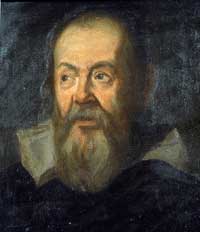
Click on my face for fun!
Galileo Galilei (1564 - 1642)
Galileo is generally given recognition for discrediting the Ptolemaic model. His contributions to astronomy, physics, and the fields of science in general can not be understated. He laid down the foundations of modern physics (which were later formalized by Newton) ... first used a telescope to make incredible astronomical observations ... and defined the way all sciences investigate our universe by outlining the "scientific method". Both stubborn and intelligent, Galileo literally "took on" the establishment at great personal risk and sacrifice.
Galileo showed his gifts at an early age. In 1582 he discovered the natural laws governing swinging pendulums ... showing how the oscillation time is related to the length of the string. This led him to mathematics where he became a professor at Pisa (his birth town) in 1589. There he challenged the ideas laid down by Aristotle which held that heavy objects fall fast and light ones fall slow. He was known to test this idea by dropping large objects from tall buildings ... showing that objects of all different weights fall with nearly the same motion (he even attributed the small differences to air friction). It soon became apparent that Galileo was not afraid to challenge authority.
The goal of science is to learn about the universe we live in and try to understand it. Galileo was responsible for laying down the "rules" by which science proceeds in that quest. This is known as the "scientific method". The first unit in this project contained a page which was dedicated to understanding this methodology. It is important for all students to understand the way science works ... no matter which science class you may be taking. For now, we will concentrate on Galileo's astronomical contributions.
When word reached Galileo that a Dutch lens maker named Hans Lippershey, (1608) had invented the first telescope, he quickly fashioned one of his own. Galileo's small powered scope (only 3X magnification) was the first telescope used for astronomical observations and led Galileo on his lifelong quest to dethrone the Ptolemaic model. From 1609-1610, Galileo used this (and a second more powerful telescope) to see the skies in a new way. With even a moderate "parlor" telescope, you should be able to repeat the same observations.
It was commonly believed that the moon (like all heavenly objects) were perfect spheres. One look through even a small telescope reveals quite a different story. Galileo noticed lunar mountains and craters. He observed that the "dark patches" appeared extremely smooth and thought these areas were "seas" ... giving them the Latin name Mare (we now know that there are no "seas" of water on the moon). It should be obvious that these findings were in sharp contrast to the Ptolemaic view of the universe. One opponent even suggested that the lunar valleys were filled with an invisible crystalline material which made the moon, in reality, a perfect sphere.
Later Galileo observed "spots" on the sun ... showing it, too, was imperfect. These sunspots changed shape as they moved across the disk of the sun. Naked eye observations in the past revealed "blemishes" on the sun ... but it was always assumed that they were caused by a passage of Mercury across the face of the sun. Galileo showed conclusively that these spots were on the "surface" of the sun and even claimed (correctly) that the sun must rotate with a period of about a month. His observations of the sun may have contributed to the blindness he suffered later in his life.

courtesy
http://quest.arc.nasa.gov/mars/teachers/tg/program3/3.2moon.gif
Cratered Lunar Surface
On January 7, 1610 Galileo turned his telescope toward Jupiter and observed new "bodies" which were not fixed stars but objects which accompanied Jupiter as it moved. He had discovered 4 moons going around Jupiter and are today known as the Galilean Satellites (even though many more moons have since been discovered orbiting Jupiter).
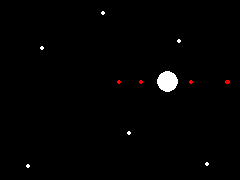
The Galilean Moons (animation)
This observation is significant because it showed that Earth is not the center of all motion ... an idea held by Ptolemy. It also made mute an argument the Greeks used to argue against a moving Earth. They reasoned that if Earth were in motion about a stationary sun, it would leave its moon behind. Clearly this was not the case with Jupiter. Galileo knew this discovery would cause controversy with the church, so he has the foresight to name these moons the "Medician stars" ... the family name of a powerful church leader.
Probably the most significant observation Galileo made with his telescope was when he looked at Venus. He observed that it went through phases similar to the phases of the moon.
Drawings of Venus by Galileo
Why is this critical? In the Ptolemaic universe, Venus would orbit Earth, but it would also never stray very far from the sun either. Its epicycle would never carry it more than about 46 degrees from the sun. In the Ptolemaic model, the sun was farther away from us than Venus. This meant that it would always be illuminated from the "back side" and as a result, only be seen as a crescent from Earth. Study the animation below.
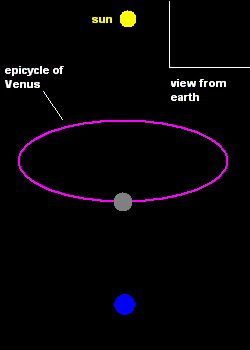
Ptolemaic view of Venus (animation)
This is not what was observed by Galileo ... he saw all the phases. This single observation shows that the Ptolemaic model was wrong! It does, however, fit nicely in the heliocentric universe of Copernicus as seen in the animation below. As a result, Galileo strongly supported the "sun -centered" model.
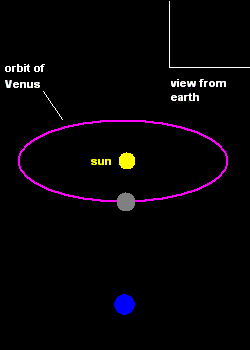
Copernican view of Venus (animation)
Throughout his career, Galileo was trying to understand the fundamentals of "natural motion". That is, he challenged the ideas laid down by Aristotle which stated that all moving objects will naturally come to a state of rest. In that quest, he formalized the mathematical relationships between distance, velocity, and acceleration and showed that the "natural" state of moving objects is to continue moving at a constant speed (which is generally regarded as a law credited to Newton). These basic ideas about the behavior of moving objects set the stage for Sir Isaac Newton's work, but also helped Galileo understand the physics of a moving Earth (which was essential to establish if Earth was indeed moving in space). For example, one common argument against a moving Earth dealt with falling objects. The common thought was that if an object fell on a moving Earth, it would not fall straight down as seen by the observer ... since that person was moving (see the animation below).
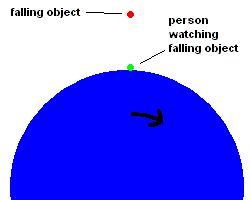
Argument against a moving Earth (animation)
Galileo argued that when the falling object is initially released, it will carry, with it, the motion of Earth and as a result, appear to fall straight down (as seen by the observer). To prove his point, he dropped objects from moving platforms to show that this was indeed the case.

Galileo's demonstration (animation)
As a result of this pioneering work in modern physics, Galileo was able to invalidate the arguments the Greeks proposed against a moving Earth.
Unlike Kepler who lived in northern Europe, Galileo literally lived in the backyard of the church. Since the Ptolemaic model was upheld by the church, Galileo's observations drew him into political controversy. In 1616, Rome officially decreed that Galileo may only treat the Copernican model as a hypothesis and not as fact. He was actually highly respected by the church and even had friendly relationships with several high-ranking officials. These allies provided a level of protection as long as Galileo did not try to push the matter fully. He pushed! In 1630 he wrote Dialogue on the Two Chief World Systems in which 3 characters argued the merits of the geocentric and heliocentric models. The character who argues the Ptolemaic position was a simpleton and the reigning Pope felt he was being depicted as this sophomoric character. This led to a trial before the Inquisition in 1633 in which Galileo was forced to confess his errors (under threat of torture). He did confess (he was nearly 70 and in poor health) and was placed under house arrest for the remainder of his life. It was rumored that during the signing of his "confession", Galileo uttered (in Latin) ... None-the-less, it moves (referring to Earth). Of course, the church ultimately conceded the point and even (in 1992) granted Galileo an official apology. Galileo was not just a great scholar ... he showed (by example) how science proceeds, as it attempts to unravel the mysteries of the universe ... sometimes at great personal risk.
Click here for an excellent online overview of the life of Galileo.
ŠJim Mihal 2004, 2014, 2023 - all rights reserved